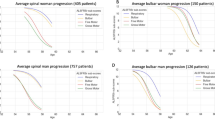Abstract
The aim of the study is to determine the shape of the progression curve in ALS, assess the impact of clinical variables on the rate of progression, and evaluate the association between functional decline and survival. Data were prospectively collected and entered into a clinical database from all patients seen in 2002–2008 at the Centre SLA, Hôpital de la Salpêtrière, Paris. Variables analyzed were demographic and baseline information, the ALS functional rating scale (ALSFRS-R), strength testing (MMT), and survival. Generalized additive mixed models characterized changes in ALSFRS-R and MMT scores over time. Linear mixed effects assessed the impact of demographic and clinical measures on rate of progression and Cox models examined their effect on survival. Of 2,452 patients with ALS identified, 1,884 had adequate data for analysis. The ALSFRS-R and MMT declined in a curvilinear way; a quadratic fit described the trends but a linear fit did not. The total ALSFRS-R score was negatively associated with age-of-onset (p < 0.001), and positively associated with baseline ALSFRS-R (p < 0.001) as well as more severe bulbar features (p < 0.001). Higher rate of decline in ALSFRS-R and MMT, older age-at-onset and bulbar-onset predicted shorter survival. Deterioration in ALS is non-linear. The early and late phases of the illness show the most rapid rates of decline. Older age and bulbar signs are associated with a steeper decline, and along with more rapid initial rate of decline, but not current functional status, also predict survival.

Similar content being viewed by others
References
Rowland LP, Shneider NA (2001) Amyotrophic lateral sclerosis. N Engl J Med 344:1688–1700
Meininger V, Binsimon G, Lacomblez L, Salachas F (1995) Natural history of amyotrophic lateral sclerosis: a discussion. Adv Neurol 68:199–207
Guiloff RJ, Goonetilleke A (1995) Natural history of amyotrophic lateral sclerosis: observations with the charing cross amyotrophic lateral sclerosis rating scales. Adv Neurol 68:185–198
Pradas J, Finison L, Andres PL, Thornell B, Hollander D, Munsat TL (1993) The natural history of amyotrophic lateral sclerosis and the use of natural history controls in therapeutic trials. Neurology 43:751–755
Moore DH, Miller RG (2004) Improving efficiency of ALS clinical trials using lead-in designs. Amyotroph Lateral Scler Other Motor Neuron Disord 5:57–60
Gordon PH, Moore DH, Miller RG et al (2007) Minocycline is not effective for amyotrophic lateral sclerosis: a phase III randomized controlled trial. Lancet Neurol 6:1045–1053
Miller RG, Moore DH (2004) ALS trial design: expectation and reality. Amyotroph Lateral Scler Other Motor neuron Disord 5:52–54
Gordon PH, Corcia P, Lacomblez L et al (2009) Defining survival as an outcome measure in amyotrophic lateral sclerosis. Arch Neurol 66:758–761
Cedarbaum JM, Stambler N, Malta E et al (1999) The ALSFRS-R: a revised ALS functional rating scale that incorporates assessments of respiratory function. BDNF ALS Study Group (Phase II/III). J Neurol Sci 169:13–21
ALS Great Lakes Study Group (2003) A comparison of muscle strength testing techniques in amyotrophic lateral sclerosis. Neurology 61:1503–1507
Brooks BR, Miller RG, Swash M, Munsat TL (2000) World Federation of Neurology Research Group on Motor Neuron Diseases. El Escorial revisited: revised criteria for the diagnosis of amyotrophic lateral sclerosis. Amyotroph Lateral Scler Other Motor Neuron Disord 1:293–299
A double-blind placebo-controlled clinical trial of subcutaneous recombinant human ciliary neurotrophic factor (rHCNTF) in amyotrophic lateral sclerosis (1996) ALS CNTF Treatment Study Group. Neurology 46:1244–1249
Meininger V, Drory VE, Leigh PN, Ludolph A, Robberecht W, Silani V (2009) Glatiramer acetate has no impact on disease progression in ALS at 40 mg/day: a double-blind, randomized, multicentre, placebo-controlled trial. Amyotroph Lateral Scler 1:1–7
Jenkins BG, Kilvenyi P, Kustermann E et al (2000) Nonlinear decrease over time in N-acetyl aspartate levels in the absence of neuronal loss and increases in glutamine and glucose in transgenic Huntington’s disease mice. J Neurochem 74:2108–2119
Rockwood K, Dai D, Mitnitski A (2008) Patterns of decline and evidence of subgroups in patients with Alzheimer’s disease taking galantamine for up to 48 months. Int J Geriatr Psychiatry 23:207–214
Kempster PA, Williams DR, Selikhova M, Holton J, Revesz T, Lees AJ (2007) Patterns of levodopa response in Parkinson’s disease: a clinicopathological study. Brain 130:2123–2128
Rosenblatt A, Liang KY, Zhou H et al (2006) The association of CAG repeat length with clinical progression in Huntington disease. Neurology 66:1016–1020
Martins CA, Oulhaj A, de Jager CA, Williams JH (2005) ApoE alleles predict the rate of cognitive decline in Alzheimer disease: a nonlinear model. Neurology 65:1888–1893
Bracco L, Piccini C, Baccini M et al (2007) Pattern and progression of cognitive decline in Alzheimer’s disease: role of premorbid intelligence and ApoE genotype. Dement Geriatr Cogn Disord 24:483–491
Kaufman Y, Anaki D, Binns M, Freedman M (2007) Cognitive decline in Alzheimer disease: impact of spirituality, religiosity, and QOL. Neurology 68:1509–1514
Small BJ, Backman L (2007) Longitudinal trajectories of cognitive change in preclinical Alzheimer’s disease: a growth mixture modeling analysis. Cortex 43:826–834
Mitnitski AB, Graham JE, Mogilner AJ, Rockwood K (1999) The rate of decline in function in Alzheimer’s disease and other dementias. J Gerontol A Biol Sci Med Sci 54:M65–M69
Armon C, Graves MC, Moses D et al (2000) Linear estimates of disease progression predict survival in patients with amyotrophic lateral sclerosis. Muscle Nerve 23:874–882
Milliken JK, Edland SD (2000) Mixed effect models of longitudinal Alzheimer’s disease data: a cautionary note. Stat Med 19:1617–1629
Guimaraes P, Kieburtz K, Goetz CG et al (2005) Non-linearity of Parkinson’s disease progression: implication for sample size calculations in clinical trials. Clin Trials 2:509–518
Kimura F, Fujimura C, Ishida S, Nakajima H, Furutama D, Uehara H, Shinoda K, Sugino M, Hanafusa T (2006) Progression rate of ALSFRS-R at time of diagnosis predicts survival time in ALS. Neurology 66:265–267
Gordon PH, Cheung YK (2006) Progression rate of ALSFRS-R at time of diagnosis predicts survival time in ALS. Neurology 67:1314–1315
Conflict of interest statement
None.
Author information
Authors and Affiliations
Corresponding author
Rights and permissions
About this article
Cite this article
Gordon, P.H., Cheng, B., Salachas, F. et al. Progression in ALS is not linear but is curvilinear. J Neurol 257, 1713–1717 (2010). https://doi.org/10.1007/s00415-010-5609-1
Received:
Accepted:
Published:
Issue Date:
DOI: https://doi.org/10.1007/s00415-010-5609-1




